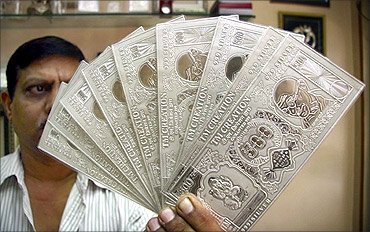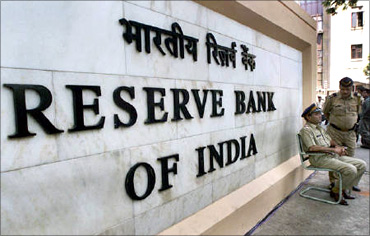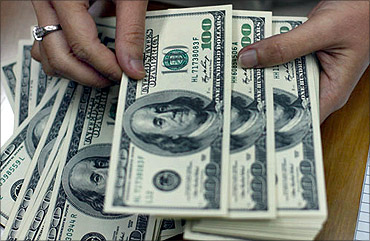Budget: The math looks dodgy
Last updated on: March 2, 2011 16:26 IST
Image: Rupee notes in silver.
Photographs: Reuters.
Akash Prakash
The finance minister (FM) has done, for once, a good job of giving a positive spin to the Budget and its arithmetic. He positively surprised the market by delivering a fiscal deficit number of 5.1 per cent in FY11 and proposed 4.6 per cent in FY12.
The 4.6 per cent number is way below embedded market expectations of 5.1 to 5.2 per cent for FY12. He has managed to get to these numbers without any windfall like an amnesty scheme or asset auctions, which makes it even more creditable.
The problem, however, is that his math seems dodgy. He has actually budgeted for a decline in subsidies in FY12!
. . .

Budget: The math looks dodgy
Image: Reduction in oil subsidies.
The FM has budgeted for a reduction in oil subsidies from Rs 38,000 crore (Rs 380 billion) to Rs 23,000 crore (Rs 230 billion), a drop in fertiliser subsidy from Rs 55,000 crore (Rs 550 billion) to Rs 50,000 crore and stable food subsidies at Rs 60,000 crore (Rs 600 billion).
There is no way these subsidy numbers for FY12 are even remotely credible, especially with oil at $105 a barrel. There is a minimum under-budgeting of Rs 50,000 crore.
The only way these numbers can be met is if the FM moves immediately on de-control of diesel, raises other fuel prices and goes in for a nutrient-based subsidy regime for urea (with an immediate price rise).
. . .

Budget: The math looks dodgy
Image: Nothing for Right to Food Bill.
These are great reforms if he can get them done, but the track record does not inspire confidence.
He has also not provided anything for the Right to Food Bill. Even on the revenue side, assuming an 18 to 20 per cent increase in tax revenues is ambitious (on a high base).
Thus, the entire fiscal arithmetic seems flawed, we will end with a fiscal deficit probably closer to five per cent, than 4.6 per cent.
Commensurately, the net market borrowing target is going to be closer to Rs 400,000 crore as opposed to the Rs 350,000 crore given in the Budget.
With this amount of market borrowings, interest rates and bond yields will remain under pressure.
. . .

Budget: The math looks dodgy
Image: Reserve Bank of India.
Even though the FM may not meet his targets on the fiscal, he should be commended for appearing as non-populist as we have ever seen him.
He is targeting total expenditure growth in FY12 of only 3.5 per cent over the revised estimates for FY11. He has actually budgeted a decline of one per cent in non-plan expenditure in FY12.
While he may not be as tightfisted as that, clearly the days of government expenditure growing at 15 to 18 per cent are thankfully over.
He has also taken a lot of pressure off the Reserve Bank of India (RBI), by trying to instill discipline on the spending side.
. . .

Budget: The math looks dodgy
Image: Fertiliser subsidy.
If this marks the beginnings of a desire on the part of the executive to stand up to the National Advisory Council, and its spend-at-any-cost policy orientation, it is a huge positive. The primacy of fiscal consolidation will be well received.
Thus, on the fiscal side, I would say, while things are not as good as he projected, the desire to control spending and the implicit intention to move on fuel and fertiliser subsidy is a plus.
. . .

Budget: The math looks dodgy
Image: An Indian trader wears a mask during a protest against the Value Added Tax (VAT),
Photographs: B Mathur/Reuters.
On structural reform, the clear positive to my mind is the stated intention to move to a system of cash-based subsidy for fuel and fertiliser by the end of FY12.
This is a huge structural positive, possible game changer and may also explain his under-budgeting of these two items in the Budget. We seemed to have finally moved beyond talk on this issue.
The FM also spoke at some length about Goods and Services Tax preparations, the intention to implement the Direct Taxes Code by FY12, and sent out a clear message that both these critical tax reforms would be on the statute books by FY12.
. . .

Budget: The math looks dodgy
Image: Tax burden.
The stated intention to move ahead on financial reforms, through the introduction of various financial sector Bills like Insurance and Pension Fund Regulatory and Development Authority (PFRDA), as well as the RBI outlining guidelines on new bank licences is another positive.
The promised introduction of the new Companies Act legislation is one more in a series of measures to demonstrate that this government is firmly in charge and moving ahead.
The decision to not tinker with tax rates (especially indirect taxes) but keep them stable and instead focus on reducing exemptions and laying the ground for tax policy stability is a good development.
. . .

Budget: The math looks dodgy
Image: Dollar notes,
Photographs: Reuters.
Predictability and stability of taxes is a boon and aids long-term decision making. No longer will the government change industry economics through the stroke of a pen.
The decision to raise the limit on corporate infrastructure bonds by $20 billion and making them tradeable among foreign institutional investors (FIIs), despite a five-year lock-in, is a positive, though one will have to see how FIIs use this. Allowing foreigners to invest in mutual funds is an incremental positive.
. . .

Budget: The math looks dodgy
Image: Regulatory framework around the agricultural supply chain.
As for the negatives, we missed the opportunity to allow foreign direct investment (FDI) in retail, nor was anything done to incentivise the states to clean up the regulatory framework around the agricultural supply chain (Agricultural Produce Market Committees Act, mandi tax etc.)
The whole issue of monetisation of state natural resources was dumped on another Group of Ministers (GoM) to go through the environmental regulatory environment. The market will see both of the above as ducking a decision.

Budget: The math looks dodgy
Image: Setting up of another GoM on corruption will not help.
The setting up of another GoM on corruption is not likely to inspire much confidence. The FM disappointed with no immediate movement on a nutrient-based subsidy for urea, nor was there any mention of a framework on land acquisition to enable projects to get a move on.
On the whole, a reasonable effort, better than expectations for sure, but I don't think enough has been done to break the market out of its trading range.
We will remain hostage in the short term to macro and governance headwinds, till we see action on some of the structural reform hinted at in the Budget.














article